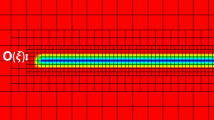Abstract
In this work, the lattice Boltzmann method is applied to study the dynamic behaviour of linear elastic solids under antiplane shear deformation. In this case, the governing set of partial differential equations reduces to a scalar wave equation for the out of plane displacement in a two dimensional domain. The lattice Boltzmann approach developed by Guangwu (J Comput Phys 161(1):61–69, 2000) in 2006 is used to solve the problem numerically. Some aspects of the scheme are highlighted, including the treatment of the boundary conditions. Subsequently, the performance of the lattice Boltzmann scheme is tested for a stationary crack problem for which an analytic solution exists. The treatment of cracks is new compared to the examples that are discussed in Guangwu’s work. Furthermore, the lattice Boltzmann simulations are compared to finite element computations. Finally, the influence of the lattice Boltzmann relaxation parameter on the stability of the scheme is illustrated.








Similar content being viewed by others

References
Chen S, Doolen GD (1998) Lattice boltzmann method for fluid flows. Annu Rev Fluid Mech 30(1):329–364
Abas A, Gan ZL, Ishak MHH, Abdullah MZ, Khor SF (2016) Lattice Boltzmann method of different BGA orientations on I-type dispensing method. PLoS ONE 11(7):1–26
Frank X, Funfschilling D, Midoux N, Li H (2006) Bubbles in a viscous liquid: lattice boltzmann simulation and experimental validation. J Fluid Mech 546:113–122
Chopard B, Marconi S (2002) Lattice Boltzmann solid particles in a lattice boltzmann fluid. J Stat Phys 107(1):23–37
Chopard B, Luthi PO (1999) Lattice Boltzmann computations and applications to physics. Theor Comput Sci 217(1):115–130
Yan G (2000) A lattice Boltzmann equation for waves. J Comput Phys 161(1):61–69
Frantziskonis GN (2011) Lattice Boltzmann method for multimode wave propagation in viscoelastic media and in elastic solids. Phys Rev E 83:066703
Xiao S (2007) A lattice Boltzmann method for shock wave propagation in solids. Comm Numer Meth Eng 23(1):71–84
Chopard B, Luthi P, Marconi S (1998) A lattice Boltzmann model for wave and fracture phenomena. arXiv:cond-mat/9812220
Kwon Y, Hosoglu S (2008) Application of lattice Boltzmann method, finite element method, and cellular automata and their coupling to wave propagation problems. Comput Struct 86(7):663–670
Bhatnagar PL, Gross EP, Krook M (1954) A model for collision processes in gases. I. Small amplitude processes in charged and neutral one-component systems. Phys Rev 94:511–525
Welander P (1954) On the temperature jump in a rarefied gas. Ark Fys 7:507
Sterling JD, Chen S (1996) Stability analysis of lattice Boltzmann methods. J Comput Phys 123(1):196–206
Irwin GR (1957) Analysis of stresses and strains near the end of a crack traversing a plate. J Appl Mech 24:361–364
Burridge R (1969) The numerical solution of certain integral equations with non-integrable kernels arising in the theory of crack propagation and elastic wave diffraction. Philos Trans R Soc A 265(1163):353–381
Thau SA, Lu T-H (1970) Diffraction of transient horizontal shear waves by a finite crack and a finite rigid ribbon. Int J Eng Sci 8(10):857–874
Author information
Authors and Affiliations
Corresponding author
Rights and permissions
About this article
Cite this article
Schlüter, A., Kuhn, C. & Müller, R. Lattice Boltzmann simulation of antiplane shear loading of a stationary crack. Comput Mech 62, 1059–1069 (2018). https://doi.org/10.1007/s00466-018-1550-4
Received:
Accepted:
Published:
Issue Date:
DOI: https://doi.org/10.1007/s00466-018-1550-4



